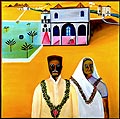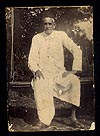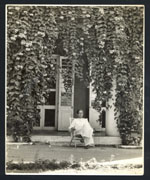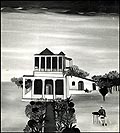Bhupen KHAKHAR India b.1934
Portraits of my mother and my father going to Yatra
1971
Oil on canvas 106.5 x 107cm
Purchased 1998.
Queensland Art Gallery Foundation Grant
Collection: Queensland Art Gallery
Reproduced by permission
of the artist
|
 |
 |
Parmanand
Kalidas Khakhar, the artist's father, 1937
Photo courtesy Bhupen Khakhar and Gallery Chemould
Published in Timothy Hyman, Bhupen Khakhar, Chemould
Publications and Arts, Bombay, & Mapin Publishing, Ahmedabad,
India, 1998, p.117. |
This painting is a rare representation
of Khakhar's parents. In the background is the 'Residency
Bungalow' in Baroda, which was Khakhar's home during the 1970s
after he had left Bombay. The word 'yatra' means pilgrimage,
which is an important journey to visit specific religious
sites. Khakhar paints his parents, garlanded for the auspicious
event, about to embark on their first pilgrimage before his
birth. Yet curiously, it is Khakhar who sits on the pink verandah
of his home witnessing this journey.
Khakhar paints his parents as
they might have appeared in 1971, rather than in the 1930s
when this first pilgrimage took place. His father, having
died when Khakhar was four years old, is painted from memory,
while his mother's image was made from a contemporary photograph.
This is another anachronism - one would imagine that Khakhar
would use a photograph of his father and paint his mother
from memory. Adding to this sense of time disrupted, Khakhar
depicts his mother attired in a simple white sari and without
the red kumkum marking on her forehead which, in India, declares
her widowhood.
Mahalakshmi
Khakhar, the artist's mother, 1978
Photo courtesy Bhupen Khakhar and Gallery Chemould
Published in Hyman, Bhupen Khakhar, p.117. |
 |
In
Portraits of my mother and my father going to Yatra,
the manner in which Khakhar paints the other buildings in
the landscape is in the style of pilgrim charts. These are
available from such sites as Mathura and Varanasi, and lay
out precisely the nearby sacred sites that should be incorporated
into the pilgrimage. Using the Residency Bungalow as both
central and starting points, the 'pilgrimage chart' alludes
to another personal journey, Khakhar's own artistic pilgrimage.
 |
Residency
Mandarin, Bhupen Khakhar
at Baroda, 1969-70
Courtesy Bhupen Khakhar and Gallery Chemould
Published in Hyman, Bhupen Khakhar, p.118.
|
Bhupen Khakhar was born in Bombay
in 1934 into a middle class Gujarati family. His father died
when Khakhar was four years old, and his mother, Mahalaxmi,
brought up the children. In keeping with the expectations
of the successful mercantile classes, Khakhar initially trained
as an accountant, graduating with degrees in commerce and
administration. He began painting in the early 1960s. He moved
to the University town of Baroda, north of Bombay, where he
completed a degree in Art Criticism at the Fine Art Faculty
at the M.S. University. Khakhar thus comes to painting relatively
late. His early works draw on his interest in the imagery
of Indian popular culture - cinema posters, calendar art and
street kitsch. This interest is now less apparent in the work
of Khakar, who has become an established artist and one of
India's foremost contemporary painters.
| Other
lines to follow for Bhupen Khakhar |
 |
Bhupen
KHAKHAR
Residency Bungalow
1969
Oil on canvas
91 x 91cm
Collection unknown
Photo courtesy Bhupen Khakhar and Gallery Chemould |
The Residency Bungalow pictured
in Portraits of my mother and my father going to Yatra
was Khakhar's first significant home away from Bombay. It
is an important building, as it is symbolic of the new 'artistic',
'home' and 'family' that Khakhar adopted from 1962, in Baroda.
That Khakhar paints his parents in front of the Residency
Bungalow reveals a duality in the way Khakhar might consider
his family. Acknowledging two important and parallel strands
of his life, Portraits of my mother and my father going
to Yatra is a beautiful exercise in disclosing how a portrait
can operate on many levels. Another work by Khakhar, Residency
Bungalow painted in 1969, alludes to his artistic family,
featuring long-time friend and colleague Gulammohammed Sheikh.
Gulammohammed Sheikh was influential in persuading Khakhar
to become a painter and to move to Baroda. He lived at the
Residency Bungalow for a period with Khakhar and a number
of other art-world luminaries such as K.G. Subramanyan.
|